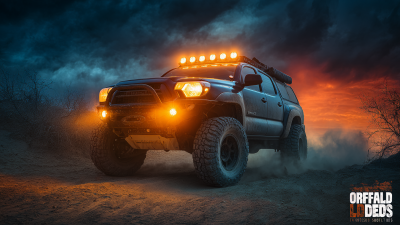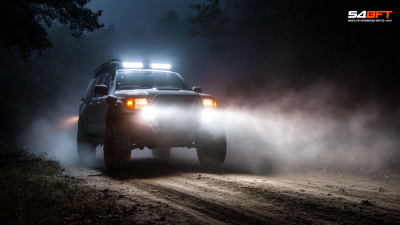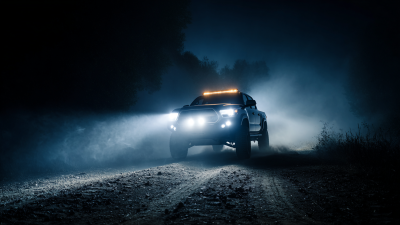When it comes to enhancing your off-road adventures, the choice of illumination plays a crucial role. Offroad LED lights not only improve visibility during night drives but also ensure your safety as you navigate through challenging terrains. According to industry expert John Adams, a renowned figure in the off-road lighting sector, "Choosing the right offroad LED lights can transform your experience, allowing you to conquer any terrain with confidence and clarity."
In this ultimate guide, we will delve into the various factors to consider when selecting offroad LED lights, including brightness, beam pattern, and durability. Whether you’re traversing rocky landscapes or muddy trails, understanding the nuances of these lights will help you make an informed decision that suits your specific off-road needs.
Join us as we illuminate the path to adventure and explore the top tips for selecting the perfect offroad LED lights, ensuring that every journey is both exhilarating and safe.

When embarking on an offroad adventure, having the right lighting is crucial for both safety and enjoyment. Offroad LED lights come in various types, each serving distinct functions depending on the terrain and conditions. Among the most common types are spotlights, which provide a focused beam ideal for illuminating distant obstacles, and floodlights that cast a wide, broad light for enhancing visibility in close-range situations.
According to recent industry reports, the global market for offroad lighting is expected to grow by 6.2% annually, highlighting a growing demand for reliable and efficient lighting options.
When selecting offroad LED lights, consider the lumens output as a key indicator of brightness. For challenging conditions, such as muddy trails or rocky terrain, lights with higher lumens (over 3,500) are recommended for optimum visibility. Additionally, ensure the lights have an IP rating of at least IP67 to withstand water and dust exposure.
Tips: Always test your lights in a controlled environment before heading out, and consider incorporating a mix of both spot and flood lights to maximize your visibility in varying terrains. Furthermore, investing in lights with adjustable mounting options can provide flexibility in directing light exactly where you need it, ensuring a smoother and safer adventure.
When selecting offroad LED lights, it's essential to evaluate the specific terrain where they'll be utilized. Different environments present unique challenges and requirements that influence light performance. For instance, rocky mountain trails require lights with high intensity and durability to withstand rough impacts, while sandy deserts benefit from lights that offer wide beam patterns to illuminate broader areas effectively.
Furthermore, in more rural or wooded terrains, lights that provide better color rendering can help detect obstacles that may not be as visible under standard lighting. Analyzing the terrain's characteristics, such as soil type and vegetation density, can mirror concepts applied in environmental assessments, where appropriate tools and techniques are implemented to gauge suitability for energy installations. Just as geospatial analysis aids in optimizing solar potential, understanding the specifics of your offroad environment is crucial for ensuring that the LED lights you choose deliver optimal visibility and safety for your adventures.
When it comes to off-road adventures, brightness and visibility are paramount for ensuring safety and enhancing the overall experience. One of the primary metrics to measure the effectiveness of LED lights is lumens, which indicates the total amount of light produced. The higher the lumen count, the brighter the light will be, making it essential to choose lights that adequately illuminate your path, especially in dark or challenging terrains.
Tips: When selecting LED lights, consider the beam pattern as well. A wider beam can offer better peripheral visibility, while a focused beam allows for longer-distance viewing. It's also important to check the color temperature of the LED lights; warmer lights (around 3000K to 4000K) can make it easier to identify objects in the dark compared to cooler lights.
Additionally, look for features such as adjustable brightness settings and strobe functions. These can provide flexibility depending on the condition and your specific needs. Make sure to read user reviews and test the lights in various conditions to determine their effectiveness and reliability. Proper installation and alignment are equally crucial for maximizing visibility and ensuring a safer off-road journey.
When it comes to enhancing your off-road adventures, choosing the right LED lights is essential. For successful installation, it's crucial to follow a systematic approach. Start by gathering the tools you'll need, including a socket set, wire strippers, and a drill. According to a 2022 report by the Off-Road Vehicle Council, proper installation of LED lights can improve visibility by up to 300%, significantly enhancing safety during nighttime excursions.
Begin the installation by identifying the optimal mounting location on your vehicle. Ensure this spot can withstand the rigors of off-road conditions. Next, securely mount the lights using brackets, ensuring they are positioned to avoid obstructing either existing lights or the vehicle's airflow. Once secured, proceed to wire the lights, taking care to connect them to a power source that can handle the load—preferably a system rated for off-road use. The Off-Road Research Institute indicates that using a relay system can prevent electrical overload and prolong the lifespan of your lights, making it a wise choice for rugged terrains.
Finally, after wiring, test the lights to confirm they're functioning correctly before heading out. Following this step-by-step guide not only ensures a smooth installation process but also enhances the performance and safety of your off-road adventures, allowing you to illuminate any terrain with confidence.
This chart illustrates the recommended LED brightness in lumens for different offroad terrains, helping you choose the best lighting setup for your adventure.
When it comes to off-road adventures, ensuring the longevity and performance of your LED lights is crucial. Proper maintenance not only enhances visibility but also saves you from costly replacements down the line. Regularly inspect your lights for any signs of wear or damage, such as cracks in the casing or loose wires. Keeping the lenses clean is another vital aspect, as dirt and grime can significantly reduce light output. Use a soft cloth and mild detergent to gently clean the surfaces after your outings.
Another essential tip for maintaining your off-road LED lights is to check the mounting hardware periodically. Vibrations from rough terrains can loosen bolts and screws, leading to misalignment or detachment of the lights. Tighten all connections and use lock washers to prevent them from loosening during your adventures. Additionally, consider investing in protective covers that shield your lights from debris and weather elements, ensuring they remain in optimal condition for years to come.
Lastly, it's advisable to avoid overloading your electrical system. Ensure that your LEDs are compatible with your vehicle's wiring to prevent short circuits or power failures. A well-maintained electrical system will not only prolong the life of your LED lights but also enhance their performance, ensuring you illuminate every trail with confidence.






